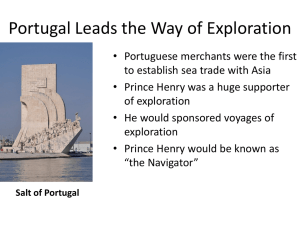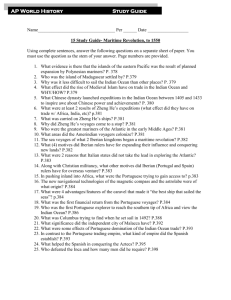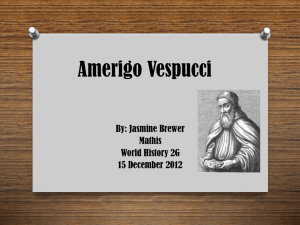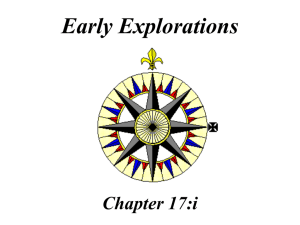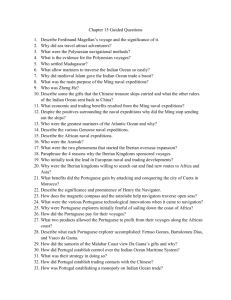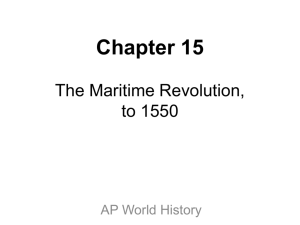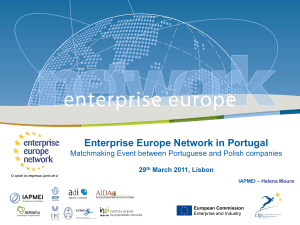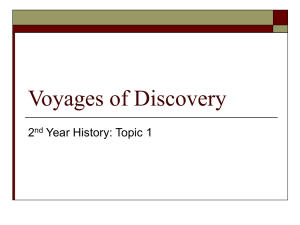17.1
advertisement
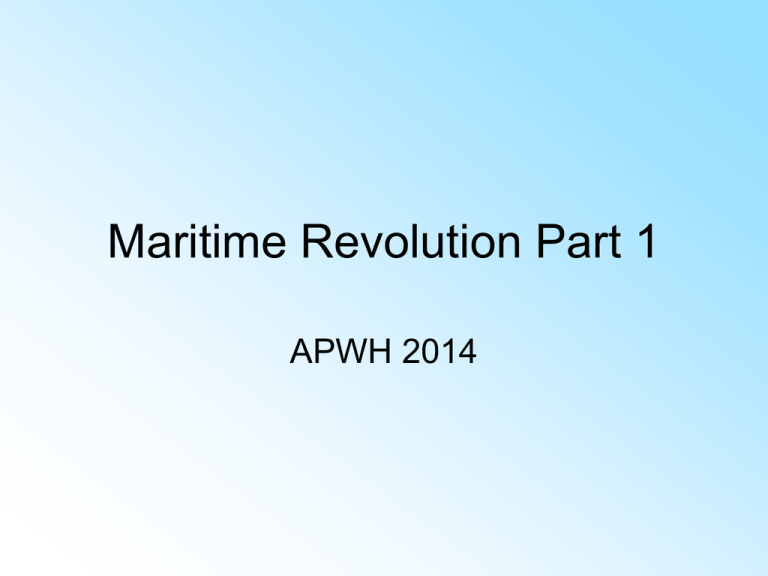
Maritime Revolution Part 1 APWH 2014 AP Test • $5.00 With waiver = Free Reduced lunch program or income requirement. • $87.00 no waiver. • March 23 Last Day to sign up. • Ms. Holmes/ - Attendance • Sign ups Mondays/Wednesday lunch only Pacific Islands • Settled by Polynesian mariners by 1300 • Evidence = 1.DNA evidence 2.Linguistic similarities 3.Transfer of indigenous plants 4.Settlements on Easter Island and New Zealand Madagascar • Settled by Malayo-Indonesians and Polynesians Indian Ocean • Easiest and least dangerous of all oceans to navigate because: • monsoon winds were predictable. • Dhow very sturdy vessel Islam and Indian Ocean Trade 1. Muslim cities in Middle East created a demand for exotic commodities 2. Muslim trade networks tied regions together 3. Muslim traders shared a common language, ethic and law 4. Islam was spread actively to distant trading cities Ming Empire in Indian Ocean • Seven Imperial fleets sent between 1405 and 1433 • Treasure ships of Zheng He carried silk, metals and other valuable gifts for distant rulers Zeng He Visits Africa 1. Zheng He extended his voyages to Africa 2. The voyages stimulated the Swahili silk market 3. At least 3 trading cities in East Africa sent delegations to China in 1415 Zeng He Visits Africa 4. The Chinese began to import more pepper •Zheng He’s voyages were discontinued in 1433 •Ming government believed little could be gained by exploring. Atlantic Ocean • Early Middle Ages the Vikings were the best mariners. • Used knowledge of the heavens and seas to travel long distances Amerindians • Natives from South America traveled up the Pacific coast • Amerindians called the Arawaks colonized the West Indies (Caribbean) Amerindians • The Carib tribe by the 15th century had overrun most of the Arawak settlements European Expansion Portugal and Spain • The two nations that began a maritime revolution that would change the course of world history. Motives for Iberian Expansion • • • • • Political Economic Religious Intellectual SPICE Ferdinand of Aragon and Isabel of Castille • Their marriage created Spain • One of the most powerful European states in the 16th century Italian States • Not interested in exploration • Trading states of Venice and Genoa preferred alliances with Muslim traders for goods. • Mediterranean ships were not built for the open Atlantic Portugal • Early motivation for exploration was to gain access to the sub-Saharan gold trade. • Explicit (Ultimate) goal was to find a passage to India Henry the Navigator (13941460) • Devoted his life to promoting exploration • third son of King of Portugal organized explorations of Southern Atlantic. Main motives (goals): • 1. Convert Africans to Christianity. • 2. Make contact with Christian rulers in Africa to establish alliances and crusade against Muslim Ottoman Turks. • 3. Discover profitable new lands. Sagres Institute • Research institute for navigation founded by Henry the Navigator • Collected information on southern Africa from location across from North Africa. • Learned from Italians about trans-Saharan trade routes and Jewish cartographers (map makers) • Created the most accurate sea charts and maps of the time period. • Henry’s ships explored the Atlantic and established colonies on Madeira in 1418 and the Azores in 1439. Naval Technology • Sagres Institute studied and improved magnetic compass (Chinese) • and astrolabe (Arab/Greek) Caravel • • • • • Fast Maneuverable Good fighting ship Strong 1/5 size of large European three-masted square-riggers and Chinese Junks. • Size allowed exploration of shallow coastal waters and strong enough to withstand ocean storms. • Equipped with lateen and square sails for performance • small cannon for defense or offense. • They were economical, fast, agile and powerful. • “The best ship that sailed the seas” of the period. Caravel v. Square rigger Lateen sails/astrolabe Trade Winds • After 1444, wind currents were discovered that blew in a circular pattern. • Explorers learned to speedily return from Africa by sailing Northwest to ride the westerly winds home. • After 1444 knowledge of trade winds allowed faster trips home. The Order of Christ • Financed Henry’s explorers until voyages became profitable. • Military/religious order founded 1318 • Received exclusive rights to promote Christianity in all new lands discovered. • *The reason Portuguese ship sails were marked with the red crusaders’ cross. Slavery • 1440’s create first financial profit for Portuguese • Captured Africans from Canary Islands and NW coast of Africa sold to European and Mediterranean traders. • By 1500 number of slaves captured or purchased reached 80,000 and rose steadily. Cruzado • New Portuguese gold coin • 1457 Gold trade surpasses slavery income in West Africa through Sahara. • Issued when Portugal began making money from Africa • Showed link between religious and secular motives. After Henry the Navigator: • Private commercial explorations provided faster results for Portugal • Fernao Gomes- 1469 • Purchased the privilege of exploring 350 mi. of new African coast a year for five years • In return holds a monopoly on trade he developed there. • Discovered Sao Tome on the equator (would become major sugar source in 1500’s). Gold Coast • Explored by Gomes • Would later become the headquarters of Portuguese West African trade in gold and slaves. • The gold Guinea coin starts to circulate Locate • • • • • Portugal Gold Coast Canary Islands Sagres Guniea Bartolomeu Diaz • 1488 • First Portuguese explorer to reach southern tip of Africa and see Indian Ocean • Bartholomew Diaz Vasco da Gama • 1497-1498 • Sailed around Africa and became first to reach India • Vasco da Gama link Pedro Alvares Cabral • 1500 • Discovered South America while looking for favorable wind around tip of Africa. • 80 years after Henry the Navigator, exploration was about to pay off big for the Portuguese! • Pedro Álvares Cabral End


